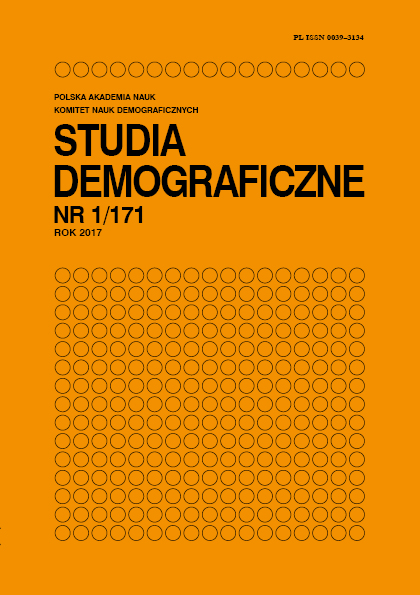Pomiar dyspersji wieku w momencie zgonu. Przyczynek do analizy kompresji umieralności w Polsce
Main Article Content
Abstract
The article presents the life-table dispersion measures and analysis results for Poland with special regard to the process of mortality compression. The following measures were analysed: Gini coefficient, average inter-individual difference in age at death, modal age at death, inter-quartile range, standard deviation above the modal age at death, person-years lost (e-dagger) and index of mortality entropy. The empirical analysis employed data for the years 1958–2014 derived from the Human Mortality Database (HMD).
The observed tendency towards reduction in the dispersion of age at death was not uniform during the 50 year span analysed and actually stagnated in certain periods. In particular, the results for the male population do not indicate a definite trend towards reduction in mortality dispersion. The results for the female population demonstrate a reduction in age dispersion at death among women over time with regard to all measures, with the modal age at death advancing towards progressively older age groups.
The dispersion measures utilised in this study and the results can be used in further research on mortality compression in Poland.
Article Details
References
[2] Canudas-Romo V., 2010, Three measures of longevity: time trends and record values, „Demography”, vol. 47, no. 2, 299–312.
[3] Cheung S.L.K., Robine J.M., 2007, Increase in common longevity and the compression of mortality: The case of Japan, „Population Studies”, vol. 61, no. 1, 85–97.
[4] Cheung S.L.K., Robine J.M., Paccaud F., Marazzi A., 2009, Dissecting the compression of mortality in Switzerland, 1876–2005, „Demographic Research”, vol. 21, 569–598.
[5] Cheung S.L.K., Robine J.M., Tu J.C.E., Caselli G., 2005, Three dimension of the survival curve: Horizontalization, verticalization, and longevity extension, „Demography”, vol. 42, no. 2, 243–258.
[6] Edwards R.D., Tuljapurka S., 2005, Inequality in life spans and a new perspective on mortality convergence across industrialized countries, „Population and Development Review”, vol. 31, no. 4, 645–674.
[7] Fries J.F., 1980, Aging, natural death, and the compression of morbidity, „The New England Journal of Medicine”, no. 303, 130–135.
[8] Fries J.F., 1989, The compression of morbidity: near or far?, „Milbank Memorial Fund Quarterly”, no. 67, 208–232.
[9] Horiuchi S., Ouellette N., Cheung S.L.K., Robine J.M., 2013, Modal age at adult death: Lifespan indicator in the era of longevity extension, „Vienna Yearbook of Population Research”, vol. 11, 37‒69.
[10] Human Mortality Database, 2016, University of California, Berkeley, USA, and Max Planck Institute for Demographic Research, Germany, Available at www.mortality.org (data dostępu: 15.06.2016).
[11] Kannisto V., 2000, Measuring the Compression of Mortality, „Demographic Research”, vol. 3 (Article 6).
[12] Kannisto V., 2001, Mode and Dispersion of the Length of Life, „Population” (English Selection), vol. 13, 159–71.
[13] Keyfitz N., 1977, Applied Mathematical Demography, New York: John Wiley.
[14] Keyfitz N., Golini A., 1975, Mortality comparisons. The male-female ratio, „Genus” 37:1–34.
[15] Nagnur D., 1986, Rectangularization of the survival curve and entropy. The Canadian experience, 1921 – 1981, „Canadian Studies in Population”, no. 3, 83–102.
[16] Nusselder W.J., Mackenbach J.P., 1996, Rectangularization of the survival Curve in the Netherlands, 1950–1992, „The Gerontologist”, vol. 36, no. 6, 773–783.
[17] Robine J.M., 2001, Redefining the stages of the epidemiological transition by a study of the dispersion of life spans: The case of France, „Population” (English Selection), vol. 13, 173–193.
[18] Shkolnikov V., Andreev E., Begun A.Z., 2003, Gini coefficient as a life table function: Computation from discrete data, decomposition of differences and empirical examples, „Demographic Research”, vol. 8(11), 305–358.
[19] Shkolnikov V.M., Andreev E.M., Zhang Z., Oeppen J., Vaupel J.W., 2011, Losses of expected lifetime in the US and other developed countries: methods and empirical analyses, „Demography”, no. 48, 211–239.
[20] Soja E., 2012, Konwergencja i dywergencja umieralności w krajach europejskich, [w:] J. Kurkiewicz (red.), Demograficzne uwarunkowania i wybrane społeczno-ekonomiczne konsekwencje starzenia się ludności w krajach europejskich (s. 173–210), Wydawnictwo Uniwersytetu Ekonomicznego w Krakowie, Kraków.
[21] Thatcher A.R., Karen S.L., Horiuchi S., Robine J.M., 2010, The compression of deaths above the mode, „Demographic Research”, vol. 22, 505–538.
[22] Vaupel J.W., 1986, How change in age-specific mortality affects life expectancy, „Population Studies”, no. 40, 147–157.
[23] Vaupel J.W., Zhang Z., van Raalte A.A., 2011, Life expectancy and disparity: an international comparison of life table data, „BMJ Open”, vol. 1(1), http://bmjopen.bmj.com/ content/1/1/e000128.full (dostęp: 2016.09.08).
[24] Véron J., Rohrbasser J.M., 2003, Wilhelm Lexis: The Normal Length of Life as an Expression of the “Nature of Things”, „Population” (English edition) vol. 3, 303–322.
[25] Wagstaff A., Paci P., van Doorslaer E., 1991, On the measurment of inequalities in health, „Social Science and Medicine”, no. 33, 545–557.
[26] Wilmoth J.R., Horiuchi S., 1999, Rectangularization revisited: Variability of age at death with human populations, „Demography”, vol. 36, no. 4, 475–495.
[27] Wróblewska W., 2006, Analiza umieralności w Polsce w latach 1970–2003. Dekompozycja zmian w oczekiwanym trwaniu życia noworodka, „Studia Demograficzne”, nr 1(149), 28–48.
[28] Yashin A.I., Begun A.S., Boiko S.I., Ukrainseva S.V., Oeppen J., 2001, The New Trends in Survival Improvement Require a Revision of Traditional Gerontological Concepts, „Experimental Gerontology”, vol. 37, no. 1, 157–167.
[29] Zhang Z., Vaupel J.W., 2009, The age separating early deaths from late deaths, „Demographic Research”, vol. 20(29), 721–730.
